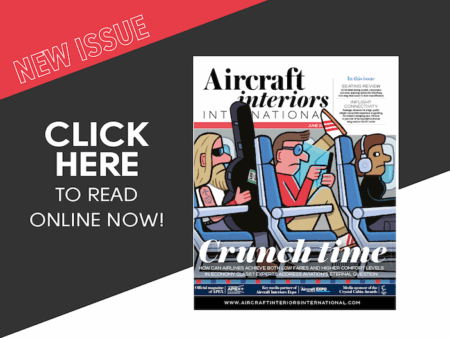In our November 2021 issue, Dr Nicola Davies explored how to enhance the passenger experience in the COVID-19 Era using insights from behavioural psychology. Dr Davies cited insights from across the psychology and science sectors, as follows:
References
- Huang C, Wang Y, Li X, Ren L, Zhao J, Hu Y, et al. Clinical features of patients infected with 2019 novel coronavirus in Wuhan, China. The Lancet. 2020 February 15;395(10223):497–506
- Garrow L, Lurkin V. How COVID-19 is impacting and reshaping the airline industry. Revenue Pricing Management. 2021 February 1;20(1):3–9
- Schultz M, Soolaki M. Analytical approach to solve the problem of aircraft passenger boarding during the coronavirus pandemic. Transp Res Part C Emerg Technol. 2021 March; 124:102931
- Schultz M, Evler J, Asadi E, Preis H, Fricke H, Wu C-L. Future aircraft turnaround operations considering post-pandemic requirements. Journal of Air Transport Management. 2020 October; 89:101886
- Salari M, Milne RJ, Delcea C, Kattan L, Cotfas L-A. Social distancing in airplane seat assignments. Journal of Air Transport Management. 2020 October 1; 89:101915
- Nir-Paz R, Grotto I, Strolov I, Salmon A, Mandelboim M, Mendelson E, et al. Absence of in-flight transmission of SARS-CoV-2 likely due to use of face masks on board. Journal of Travel Medicine. 2020 December 1;27(8). Available from: https://doi.org/10.1093/jtm/taaa117
- Wang Z, Galea ER, Grandison A, Ewer J, Jia F. Inflight Transmission of COVID-19 Based on Aerosol Dispersion Data. medRxiv. 2021 January 8;2021.01.08.21249439
- Pombal R, Hosegood I, Powell D. Risk of COVID-19 During Air Travel. JAMA. 2020 Nov 3;324(17):1798
- Freedman DO, Wilder-Smith A. In-flight transmission of SARS-CoV-2: a review of the attack rates and available data on the efficacy of face masks. J Travel Med. 2020 September 25; taaa178
- Bielecki M, Patel D, Hinkelbein J, Komorowski M, Kester J, Ebrahim S, et al. Air travel and COVID-19 prevention in the pandemic and peri-pandemic period: A narrative review. Travel Med Infect Dis. 2021; 39:101915
- Bavel JJV, Baicker K, Boggio PS, Capraro V, Cichocka A, Cikara M, et al. Using social and behavioral science to support COVID-19 pandemic response. Nat Hum Behav. 2020 May;4(5):460–71
- Kraak SBM, Hart PJB. Creating a Breeding Ground for Compliance and Honest Reporting Under the Landing Obligation: Insights from Behavioral Science. In: Uhlmann SS, Ulrich C, Kennelly SJ, editors. The European Landing Obligation: Reducing Discards in Complex, Multi-Species and Multi-Jurisdictional Fisheries. Cham: Springer International Publishing; 2019. 219–36. Available from: https://doi.org/10.1007/978-3-030-03308-8_11
- García Cueva C. Reappraising Regulatory Enforcement Through Behavioral Science. Rochester, NY: Social Science Research Network; 2016 July. Report No.: ID 3260605. Available from: https://papers.ssrn.com/abstract=3260605
- Michie S, West R, Rogers MB, Bonell C, Rubin GJ, Amlôt R. Reducing SARS-CoV-2 transmission in the UK: A behavioral science approach to identifying options for increasing adherence to social distancing and shielding vulnerable people. Br J Health Psychol. 2020 November;25(4):945–56
- Ipsos MORI. Face masks becoming normal but a flashpoint while ‘COVID-secure’ behaviors sticking. Ipsos MORI. 2020. Available from: https://www.ipsos.com/ipsos-mori/en-uk/face-masks-becoming-normal-flashpoint-while-covid-secure-behaviours-sticking
- Belot M, Choi S, Jamison JC, Papageorge NW, Tripodi E, van den Broek-Altenburg E. Six-Country Survey on COVID-19. IZA Discussion Papers; 2020. Report No.: 13230. Available from: https://www.econstor.eu/handle/10419/223672
- Fancourt DD, Bu DF, Mak DHW, Steptoe A. COVID 19 Social Study: Results Release 1. Department of Behavioral Science & Health; 2020 March p. 22
- Park CL, Russell BS, Fendrich M, Finkelstein-Fox L, Hutchison M, Becker J. Americans’ COVID-19 Stress, Coping, and Adherence to CDC Guidelines. J Gen Intern Med. 2020 August;35(8):2296–303
- Coroiu A, Moran C, Campbell T, Geller AC. Barriers and facilitators of adherence to social distancing recommendations during COVID-19 among a large international sample of adults. PLoS One. 2020 October 7;15(10):e0239795
- Gassen J, Nowak TJ, Henderson AD, Weaver SP, Baker EJ, Muehlenbein MP. Unrealistic Optimism and Risk for COVID-19 Disease. Front Psychol. 2021;12. Available from: https://www.frontiersin.org/articles/10.3389/fpsyg.2021.647461/full
- UNDP. Using behavioral insights to respond to COVID-19. United Nations Development Program. 2020. Available from: https://www.undp.org/stories/using-behavioural-insights-respond-covid-19
- Breland JY, Wong JJ, McAndrew LM. Are Common Sense Model constructs and self-efficacy simultaneously correlated with self-management behaviors and health outcomes: A systematic review. Health Psychology Open. 2020 January 1;7(1):2055102919898846
- Dixon D, Daas CD, Hubbard G, Johnston M. Using behavioral theory to understand adherence to behaviors that reduce transmission of COVID-19; evidence from the CHARIS representative national study. British Journal of Health Psychology. 2021 May 17. Available from: https://bpspsychub.onlinelibrary.wiley.com/doi/abs/10.1111/bjhp.12533
- Clark C, Davila A, Regis M, Kraus S. Predictors of COVID-19 voluntary compliance behaviors: An international investigation. Global Transitions. 2020; 2:76–82
- Thaler RH. Behavioral Economics: Past, Present, and Future. American Economic Review. 2016 July;106(7):1577–600
- Soofi M, Najafi F, Karami-Matin B. Using Insights from Behavioral Economics to Mitigate the Spread of COVID-19. Appl Health Econ Health Policy. 2020 June 1;18(3):345–50
- Okuhara T, Ishikawa H, Okada H, Kiuchi T. Identification of gain- and loss-framed cancer screening messages that appeared in municipal newsletters in Japan. BMC Res Notes. 2014 December 11; 7:896
- Gallagher KM, Updegraff JA. Health message framing effects on attitudes, intentions, and behavior: a meta-analytic review. Ann Behav Med. 2012 Febuary;43(1):101–16
- Mikels JA, Shuster MM, Thai ST, Smith-Ray R, Waugh CE, Roth K, et al. Messages that matter: Age differences in affective responses to framed health messages. Psychol Aging. 2016 June;31(4):409–14
- Mikels JA, Young NA, Liu X, Stine-Morrow EAL. Getting to the Heart of the Matter in Later Life: The Central Role of Affect in Health Message Framing. Gerontologist. 2020 September 11; gnaa128
- Van de Vyver J, Abrams D, Hopthrow T, Purewal K, de Moura GR, Meleady R. Motivating the selfish to stop idling: Self-interest cues can improve environmentally relevant driver behavior. Transportation Research Part F: Traffic Psychology and Behavior. 2018 April 1; 54:79–85
- Fleming SM, Thomas CL, Dolan RJ. Overcoming status quo bias in the human brain. PNAS. 2010 March 30;107(13):6005–9
- Gollwitzer M, Platzer C, Zwarg C, Göritz AS. Public acceptance of Covid-19 lockdown scenarios. International Journal of Psychology. 2020 October. Available from: https://onlinelibrary.wiley.com/doi/abs/10.1002/ijop.12721
- Thaler RH, Sunstein CR. Nudge: Improving Decisions about Health, Wealth, and Happiness. Yale University Press; 2008. 295 p.
- Thaler RH. From Cashews to Nudges: The Evolution of Behavioral Economics. American Economic Review. 2018 June 1;108(6):1265–87
- Nivette A, Ribeaud D, Murray A, Steinhoff A, Bechtiger L, Hepp U, et al. Non-compliance with COVID-19-related public health measures among young adults in Switzerland: Insights from a longitudinal cohort study. Soc Sci Med. 2021 January; 268:113370
- Miles D, Stedman M, Heald AH. “Stay at Home, Protect the National Health Service, Save Lives”: a cost benefit analysis of the lockdown in the United Kingdom. Int J Clin Pract. 2020 August 13; e13674
- Harjunen VJ, Spapé M, Ahmed I, Jacucci G, Ravaja N. Persuaded by the machine: The effect of virtual nonverbal cues and individual differences on compliance in economic bargaining. Computers in Human Behavior. 2018 October 1; 87:384–94
- Nevo I, Fitzpatrick M, Thomas R-E, Gluck PA, Lenchus JD, Arheart KL, et al. The Efficacy of Visual Cues to Improve Hand Hygiene Compliance. Simulation in Healthcare. 2010 December;5(6):325–31
- Mash C, Baker J, Foster C, Goldfarb J. Improved infection control compliance using isolation signs that incorporate standardized colors, visual cues, and sequenced instructions. American Journal of Infection Control. 2011 June 1;39(5):445–7
- Hellier E, Aldrich K, Wright DB, Daunt D, Edworthy J. A Multi-Dimensional Analysis of Warning Signal Words. Journal of Risk Research. 2007 April 1;10(3):323–38
- MacIntyre CR, Nguyen P-Y, Chughtai AA, Trent M, Gerber B, Steinhofel K, et al. Mask use, risk-mitigation behaviours and pandemic fatigue during the COVID-19 pandemic in five cities in Australia, the UK and USA: A cross-sectional survey. International Journal of Infectious Diseases. 2021 May 1; 106:199–207
- Roma P, Monaro M, Muzi L, Colasanti M, Ricci E, Biondi S, et al. How to Improve Compliance with Protective Health Measures during the COVID-19 Outbreak: Testing a Moderated Mediation Model and Machine Learning Algorithms. International Journal of Environmental Research and Public Health. 2020 January;17(19):7252
- Asnakew Z, Asrese K, Andualem M. Community Risk Perception and Compliance with Preventive Measures for COVID-19 Pandemic in Ethiopia. RMHP. 2020 December 8; 13:2887–97
- Franzel B, Schwiegershausen M, Heusser P, Berger B. How to locate and appraise qualitative research in complementary and alternative medicine. BMC Complementary and Alternative Medicine. 2013 June 3;13(1):125
- Ning L, Niu J, Bi X, Yang C, Liu Z, Wu Q, et al. The impacts of knowledge, risk perception, emotion and information on citizens’ protective behaviors during the outbreak of COVID-19: a cross-sectional study in China. BMC Public Health. 2020 November 23;20(1):1751
- Wright L, Steptoe A, Fancourt D. Patterns of compliance with COVID-19 preventive behaviors: a latent class analysis of 20,000 UK adults. Epidemiology; 2021 March. Available from: http://medrxiv.org/lookup/doi/10.1101/2021.03.16.21253717





